previous lesson on running a service by web interface, CLI, and script
Creating a serverless application using AWS Lambda
In the previous lesson we ended by creating a Python script that would invoke the Amazon Translate service when we ran it on our local computer. This required that the user have permissions to use the Transcribe service and required installation of Python and the boto3 module on the user’s computer. In this lesson, we’ll create the same script, but rather than having it run on the user’s computer, we will have it run in the ASW cloud.
What’s a Lambda?
Traditional multiuser computing required that a server be acquired, provisioned, and kept running all of the time that the content provider expected that an application on the server might be used. That might be efficient if there is heavy usage, but if the application on the server was only used infrequently, that’s a big waste of money and resources.
An alternative is serverless computing. In serverless computing, rather than having tasks being managed by a large application that runs all the time, the code for each task is broken down into smaller bits that only run when their particular function is required. The rest of the time, they are inactive. The activation of the code bits (called “Lambdas” by AWS) is triggered by some event. Examples might be a file landing in an S3 bucket, achieving some particular time interval (the end of a day, or hour, or week), or the completion of a task by another lambda. Complex systems can be build when a series of Lambdas are turned on and off by each other, with Lambdas sometimes chosing the next Lambda to be activated based on the outcome of their own script.
In AWS, Labmbdas can be written in several programming languages. In our example, we’ll use Python since it’s easy and we can hack the example from the previous lesson.
Setting up for AWS Lambda
Because getting the Lambda to work will require using a number of kinds of resources, we need to log in to the AWS web console as the root user instead of the IAM user we created to have restricted privileges. If you are signed into the web console as that IAM user, drop down the user options in the upper right and select Sign Out. Then log in again. If the log in screen looks like this:
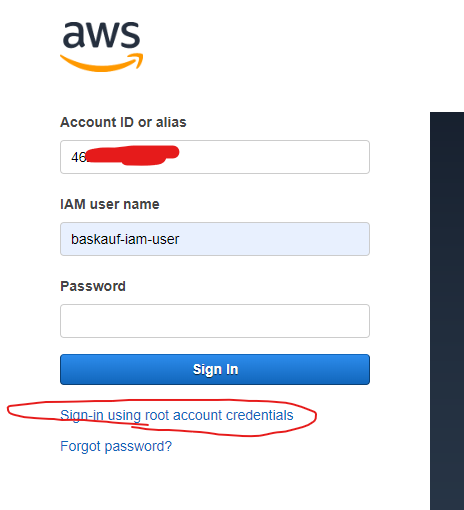
Click the link below the sign in button to go to a log in screen that will allow you to enter your email address and password.
Create a permissions role for the Lambda
Because the Lambda will be running on its own rather than being run by a particular user, we will create an IAM security role for it in the same way we created security restrictions for our IAM user. Creating the most restrictive role that will still allow a Lambda to do its job is a best practice.
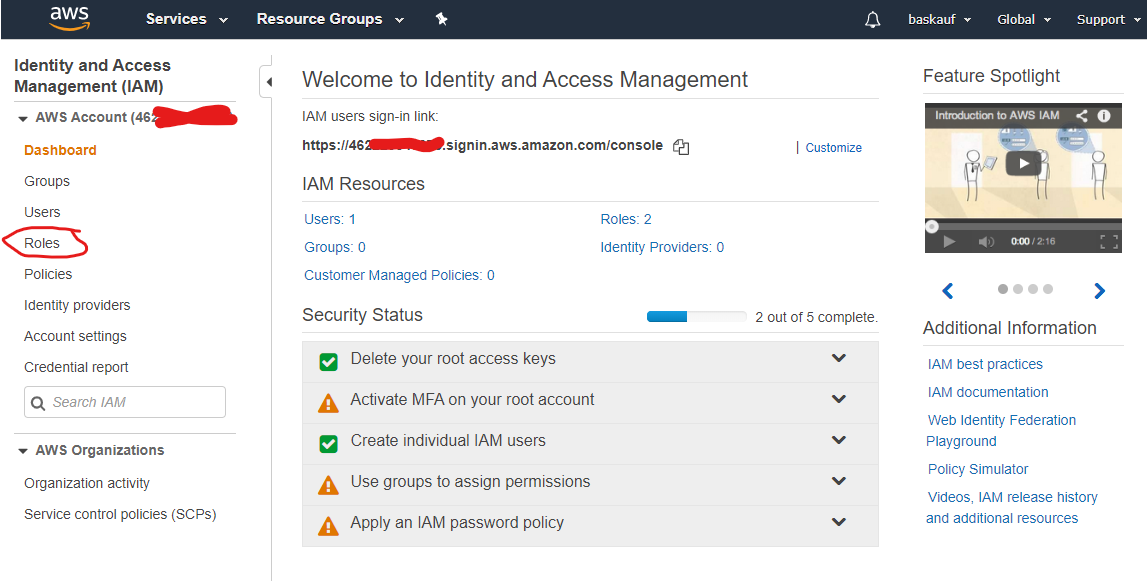
After you have logged in as the root user, from the IAM dashboard screen, select Roles

From the Role screen, click Create role.

The first step in creating the role is to designate the type of service that will use the role. Select Lambda from the large list of services, NOT from where it is listed on the upper left. That will cause it show up in the Select your use case list at the bottom. Click Lambda there, then the Next Permissions button.
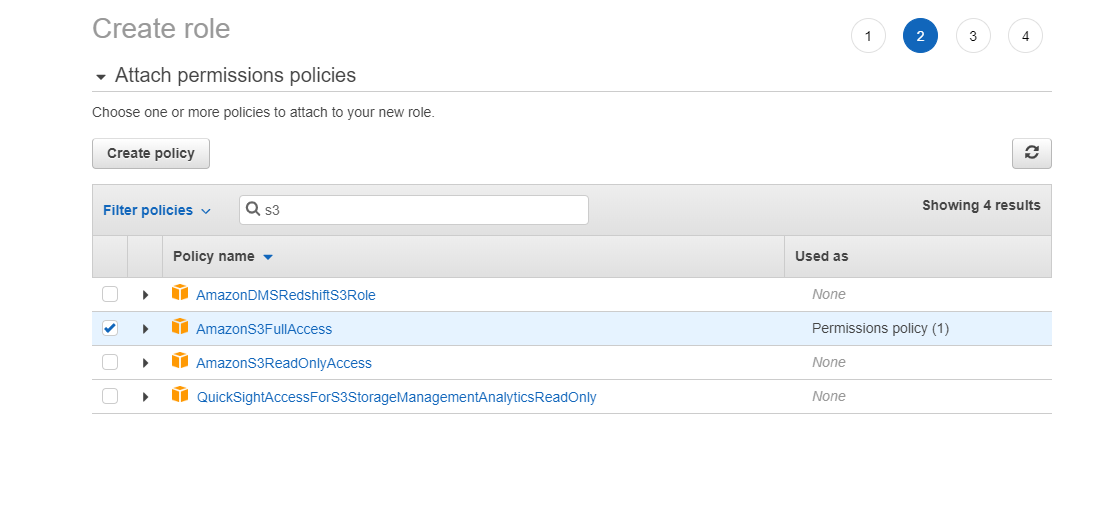
In the Filter policies box, enter s3. Check the box for AmazonS3FullAccess.

In the Filter policies box, enter translate and check the box for TranslateFullAccess.

Then in the Filter policies box, enter cloudwatchlogs and check the box for CloudWatchLogsFullAccess.
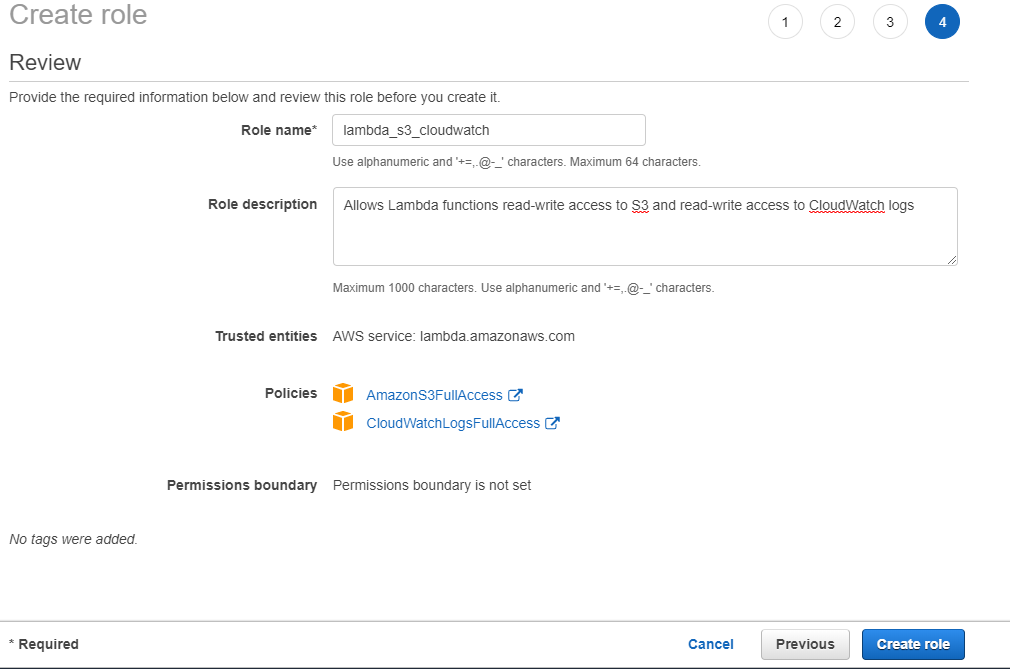
On the final screen, give the role a name. lambda_s3_cloudwatch would be good. Click the Create role button.
Create and test a Lambda
Go to the Services page and click on Lambda. Check the availability zone in the upper right and make sure that it’s the same as the one you’ve been using as your default for the IAM user (probably Ohio or N. Virginia).

Click on the Create function button.
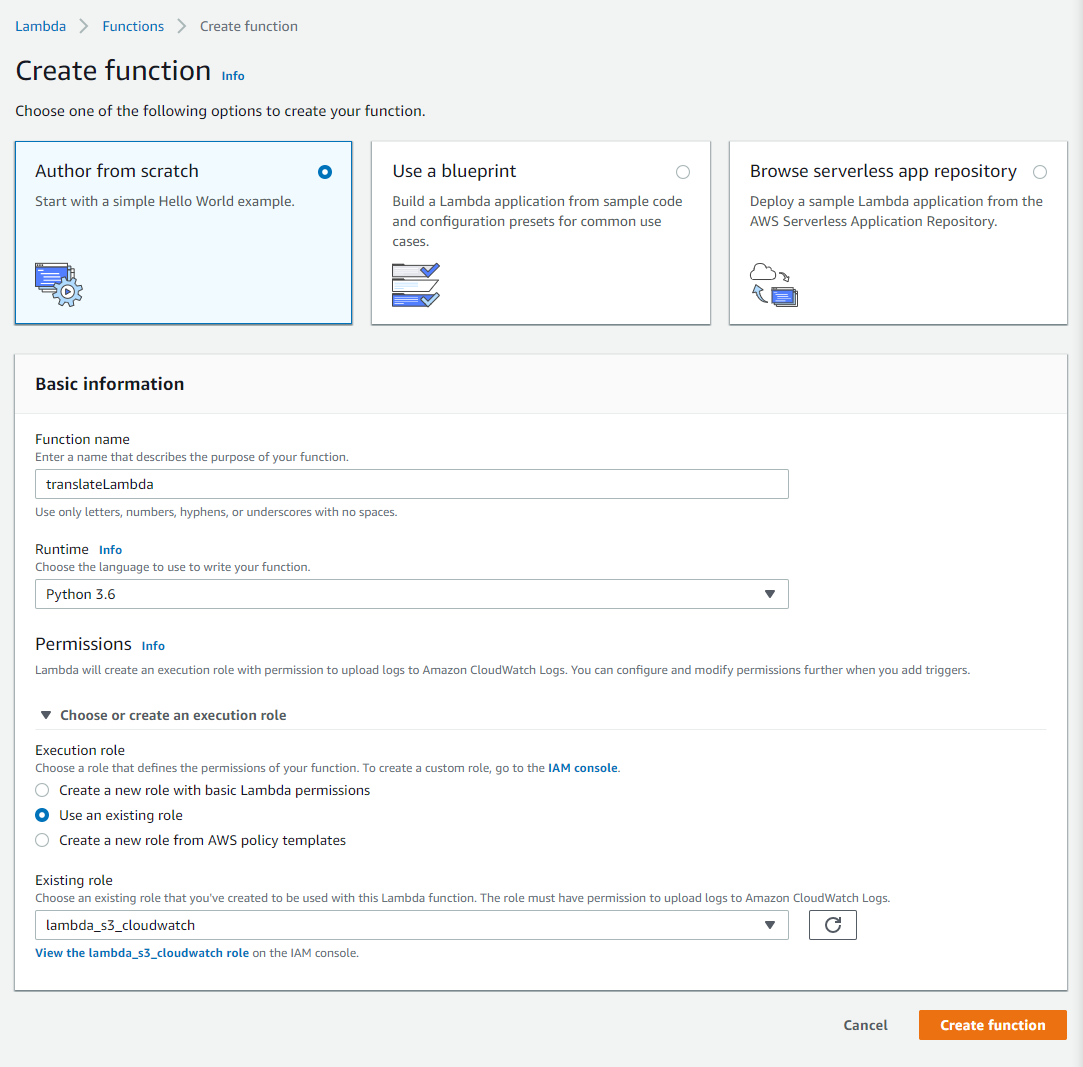
Using the Author from scratch option, enter a name for your function. Select Python 3.6 as the Runtime option. Click the triamgle to drop dow the Choose or create an execution role selection. Click the Use an existing role radio button. Select the IAM role that you created earlier. Then click the Create function button.
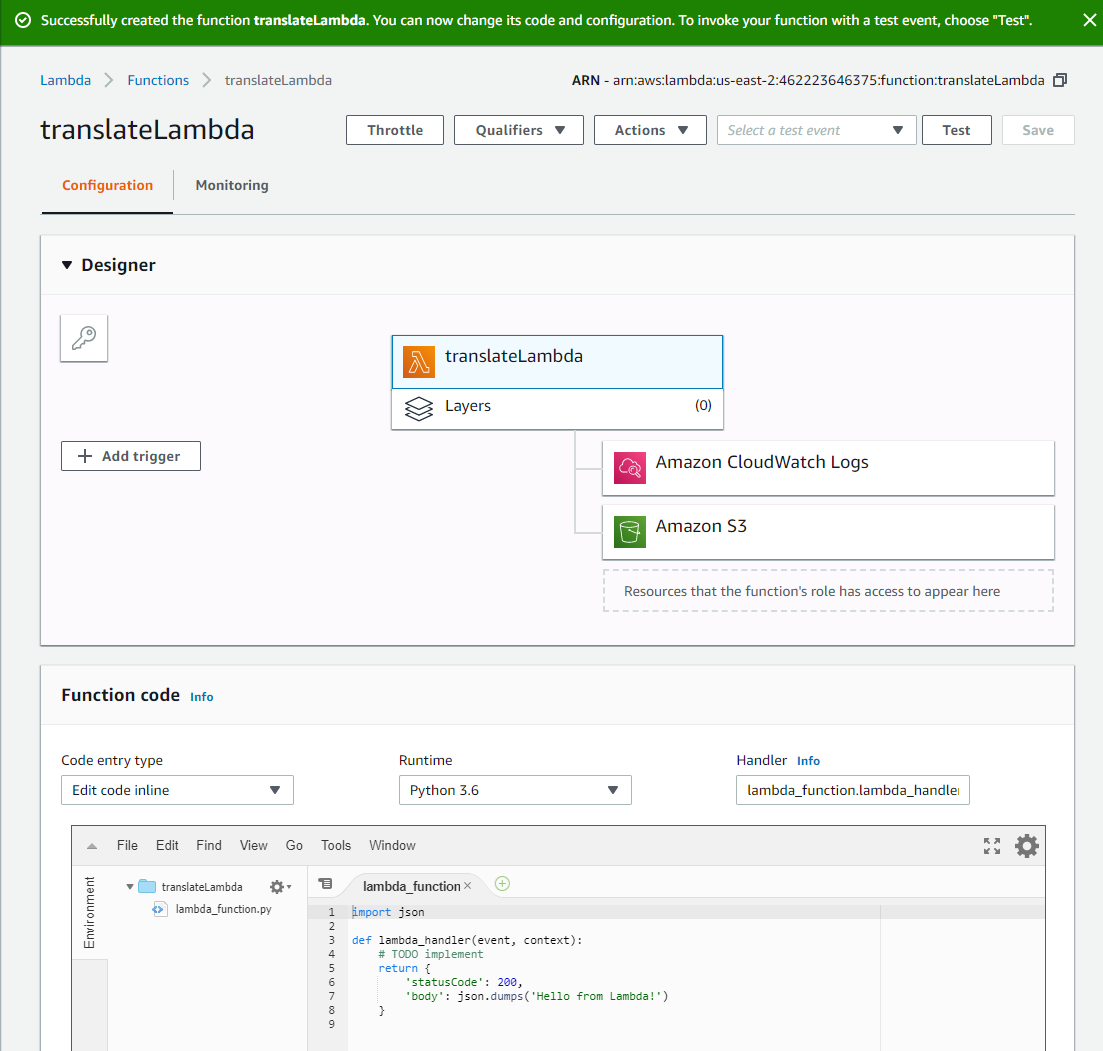
After some time, the Lambda designer screen should show up.
The Function code section in the lower part of the screen allows you to edit the code that gets executed when the Lambda runs. When the Lambda is executed, the lambda_handler() function is invoked. Two things can be passed into the function: the event parameter, which can include information passed to the function from whatever event triggers it, and the context parameter, which includes technical information about the launching of the Lambda. If anything is returned by the lambda_handler() function, it is sent to the client that invokes the function. It is also possible to use the print() function. Ouptput from print() is displayed in the log.
One can create other functions in the lambda that can be called from within the lambda_handler() function. You can also instantiate instances of AWS services (such as S3 buckets) outside of the lambda_handler() function. When instatiated there, those instances will persist for the lifetime of the lambda.
The default function just outputs some JSON to the log. We can test the function as-is by clicking on the Test button at the top of the screen and creating a test event.
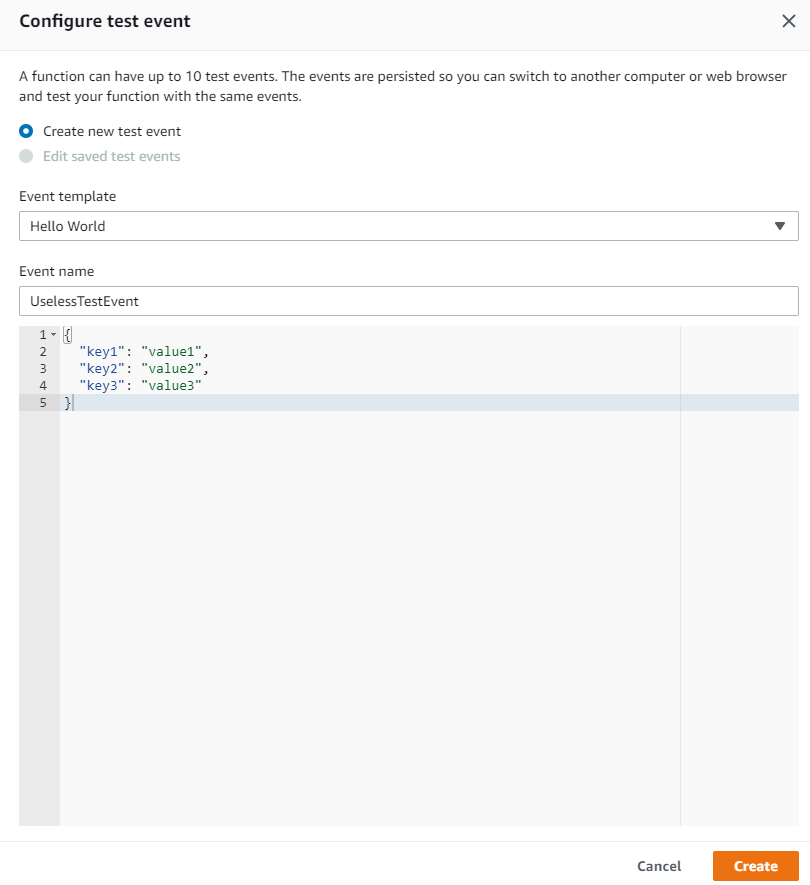
Give a name to the test event, then click Create.
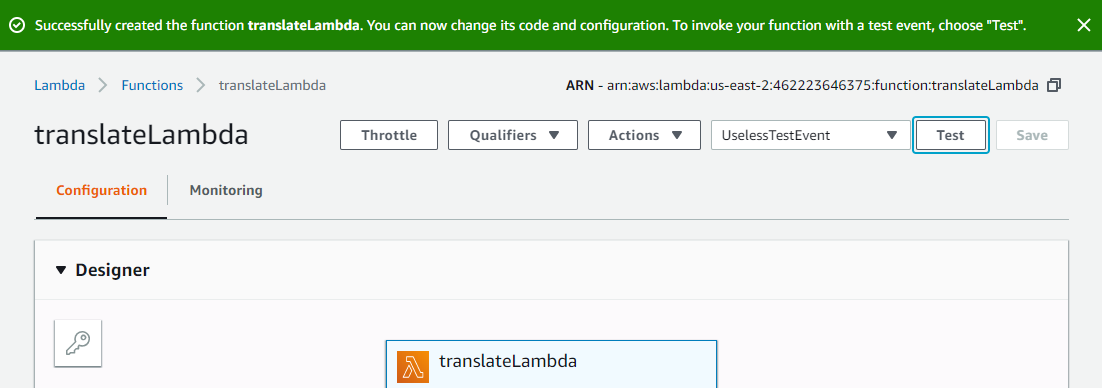
I can now test the Lambda by clicking the Test button.

After clicking Test, I see that the Lambda worked and the output was the useless JSON that the function returned.
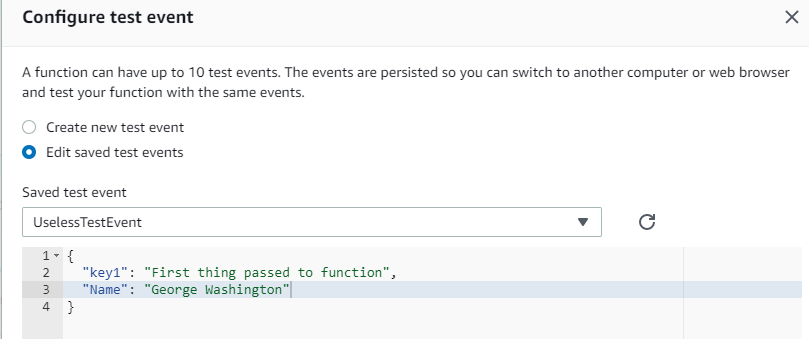
Now I’m going to try changing the JSON that gets passed into the function as the event parameter by editing my test event.
I’m also going to change the lamda_function itself by editing the text in the Function code pane, then clicking Save.

Now when I click the Test button, I see two new results. Since my new code passed the incoming event JSON straight out again as the return value, I see it listed as the Response in the Execution results pane. I also see in the Function Log entry that the string I printed out (the value of event['Name'] which was George Washington). Printing some results that will show up on the event log is a useful way to figure out what is happening in the Lambda when it gets triggered for real rather than by a test event where you can see the Response on the Function code editing screen.
Triggering the Lambda
We want to trigger the Lambda to execute when we drop a text file that needs to be translated into an S3 bucket. I’ll create a new bucket called baskauf-translate in the us-east-2 (Ohio) region to be used for that purpose.
After creating the bucket, I’ve returned to my Lambda configuration screen and clicked on the + Add trigger button on the left of the screen.
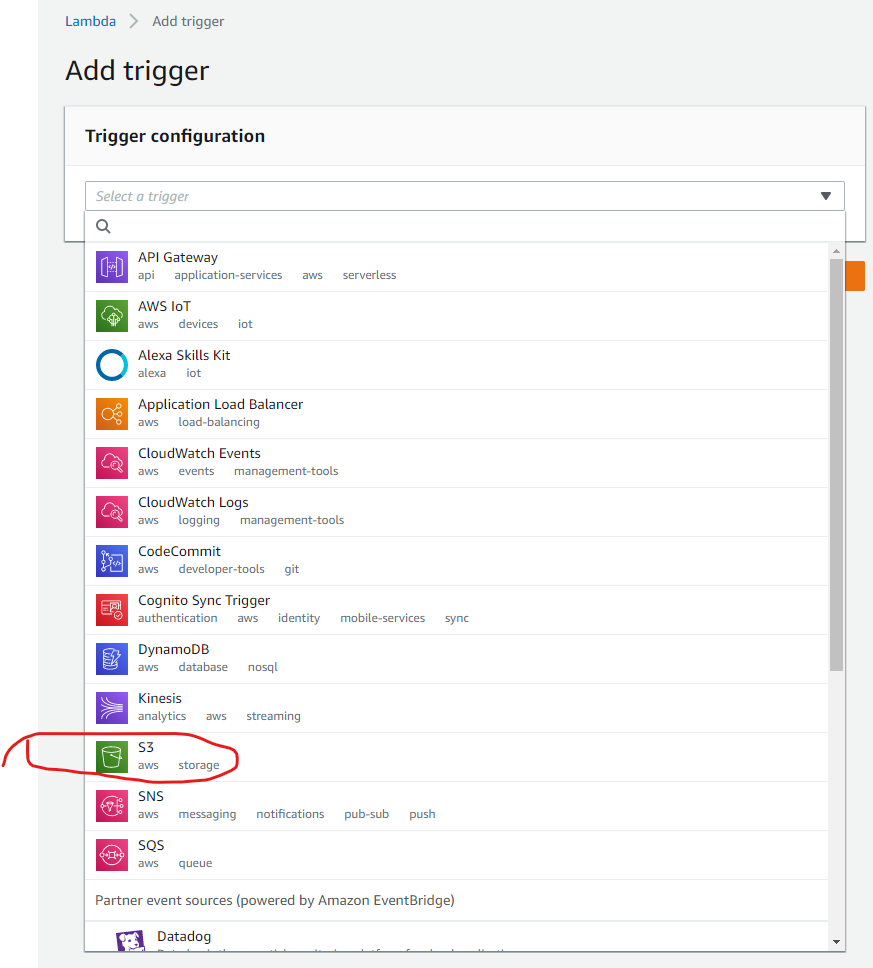
That takes me to the trigger selection screen. Select the S3 option.
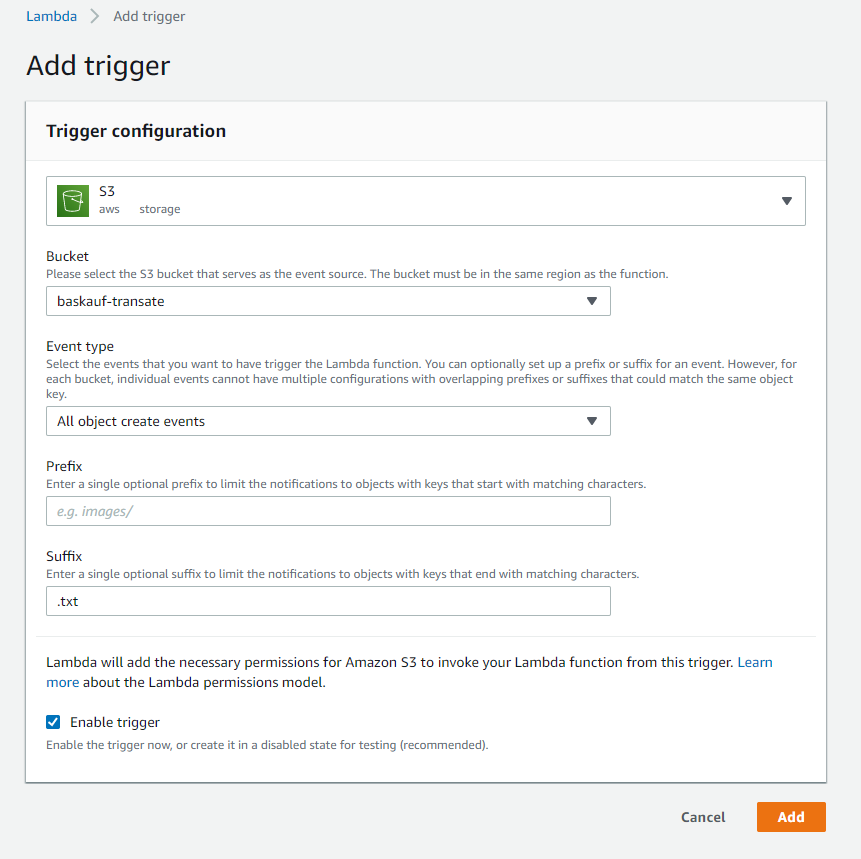
Select the bucket to be used for the trigger and use “All object create events” for Event type. I’m also restricting the triggering only to files that go into the bucket with the extension of .txt. Click Add
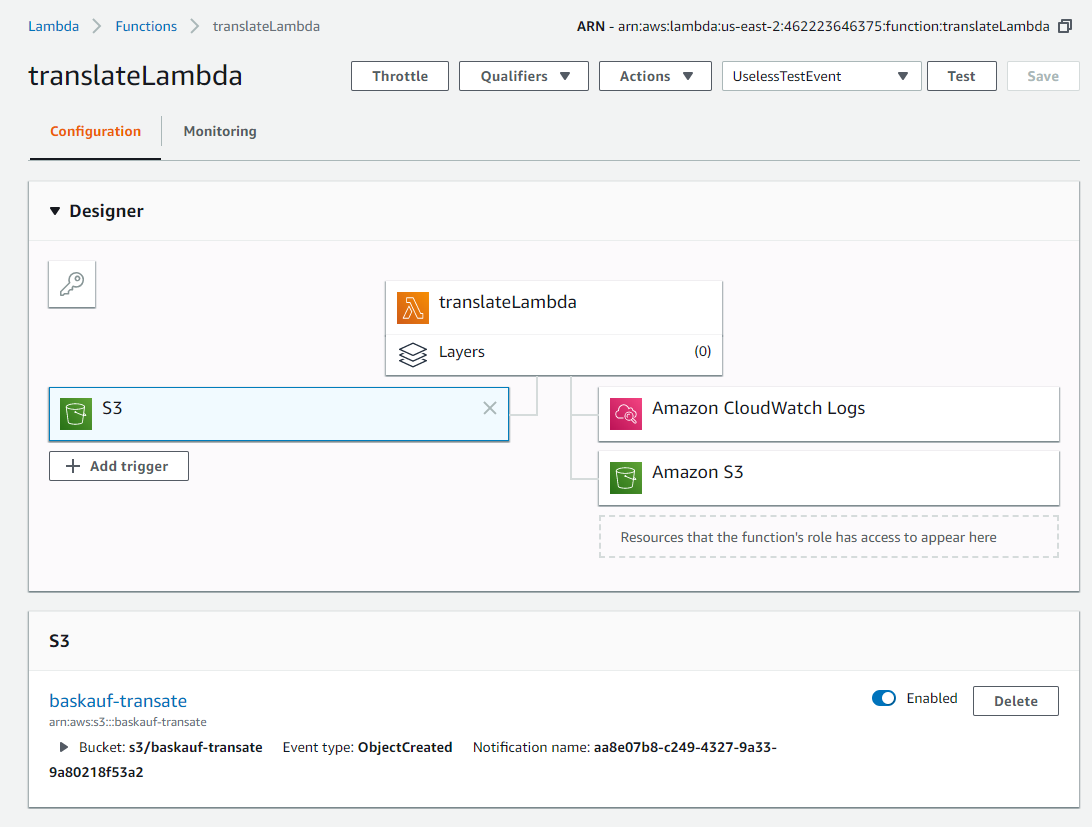
The trigger now shows up on the Configuration screen. Click on the translatLambda box to return to the Function code screen. In order to see what’s getting passed into the function when it’s triggered, I’ve added different code to print the input JSON in prettified form:
import json
def lambda_handler(event, context):
eventString = json.dumps(event, sort_keys=True)
print(eventString)
return event
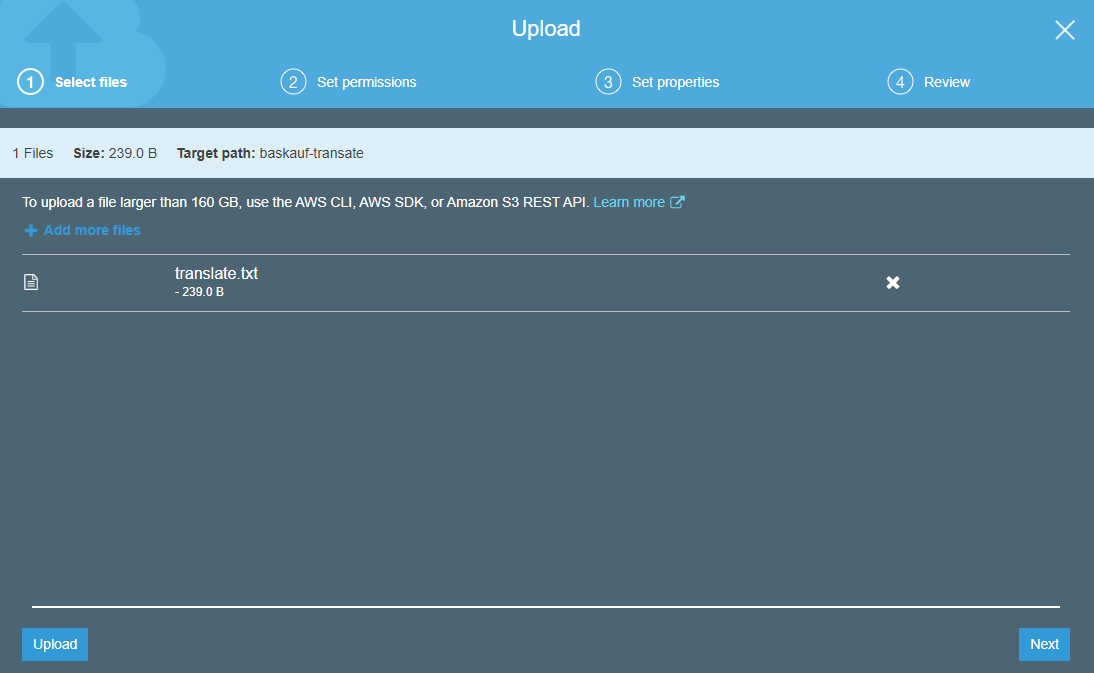
To trigger the event, I’ve uploaded the translate.txt document we were using in a previous exercise to my baskauf-translate S3 bucket.
How do I know if anything happened? The Lambda Configuration screen won’t show me anything this time because I didn’t trigger the Labda by a test. However, if I click on the Monotiring tab at the top of the screen, I can find out what happened.
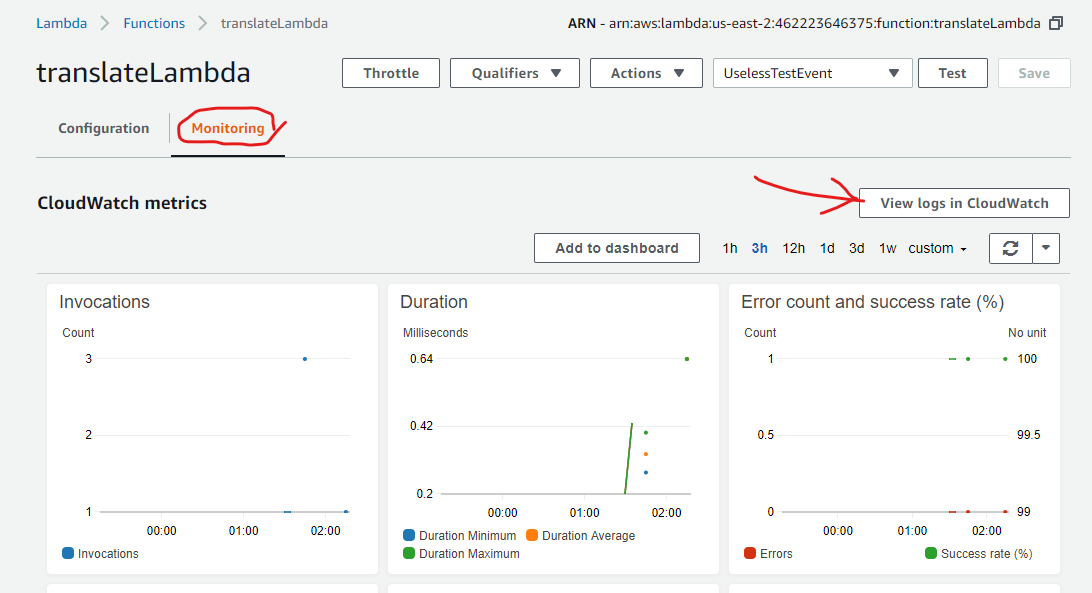
The monitoring screen has a View logs in CloudWatch button. Clicking on that button takes me to a new tab showing the CloudWatch log for the Lambda.
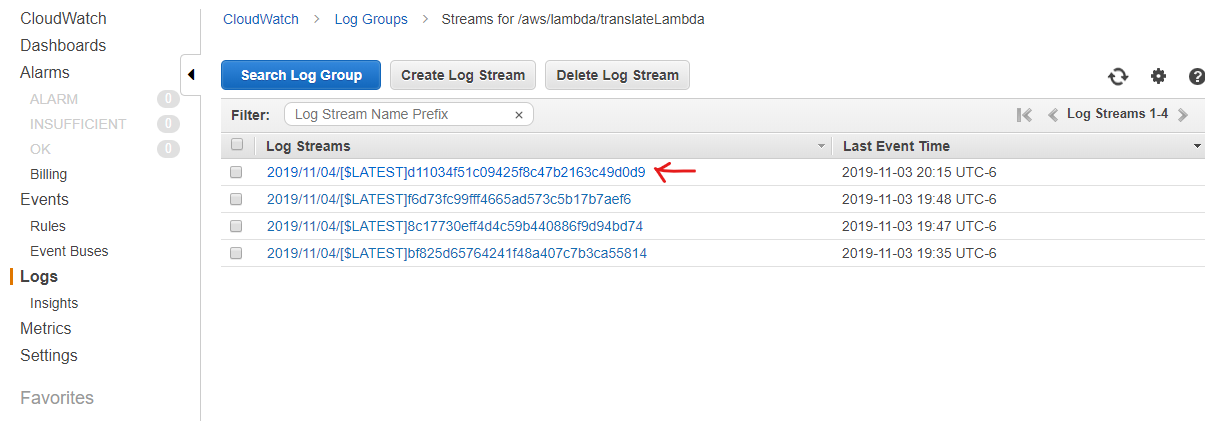
In the log list, click on the most recent event.
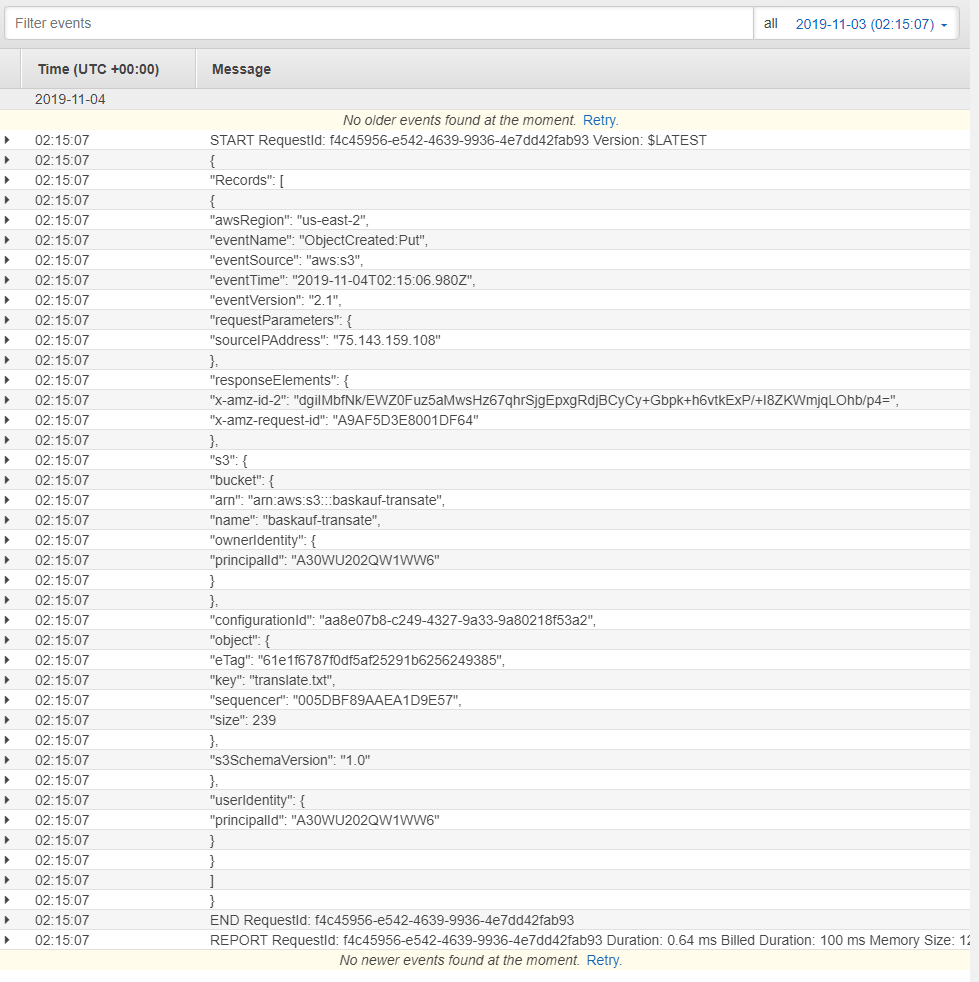
Recall that I told the scipt to print the JSON that was passed into the function. There is a lot of useless information, but an important piece of information is the name of the file that triggered the event. The path to that value would be event['Records'][0]['s3']['object']['key']
This is a somewhat painful way to look at the JSON that gets passed into the Lambda when the event is triggered. It is easier to look at the examples given in the AWS Developer Guide, which has prettier JSON examples for many services that can trigger Lambdas. For example, this page shows the event JSON for an S3 notification.
Now to test whether I can get the file name from the event string, I’ll change the script to:
import json
def lambda_handler(event, context):
name = event['Records'][0]['s3']['object']['key']
print(name)
return event
and trigger it again by deleting and re-uploading the file to the S3 bucket. If I refresh the CloudWatch log listing page, then click on the latest execution, I see the new printed results:

Success! We have the file name now. Now we can use it in our code to pass the file to Amazon Translate
Inputting the uploaded file and invoking Translate
Here’s a code snippet that retrieves the file text string from the uploaded file:
in_file = boto3.resource('s3').Bucket(inBucketName).Object(inPath) # create file object
fileBytes = in_file.get()['Body'].read() # this gets all the text in the file as a byte stream
textString = fileBytes.decode('utf-8') # decode the byte stream as UTF-8 characters.
Here’s a code snippet that will write a string to an S3 bucket:
boto3.resource('s3').Bucket(outBucketName).put_object(Key=outPath, Body=outputText)
We can combine these code snippets with code from our earlier Translate Python script to create the final Lambda:
import boto3
import json
import datetime
def lambda_handler(event, context):
# Settings
sourceLanguage = 'en'
targetLanguage = 'zh'
inSubfolder = ''
inBucketName = 'baskauf-translate'
outSubfolder = ''
outBucketName = 'baskauf-junk-123'
# Get the file name from the event parameter
inputFileName = event['Records'][0]['s3']['object']['key']
inPath = inSubfolder + inputFileName
# Make the output file name start with the input file name
firstPart = inputFileName.split('.')[0]
outputFileName = firstPart + '-translated.txt'
outPath = outSubfolder + outputFileName
# input the text to be translated from the file that dropped in the S3 bucket
in_file = boto3.resource('s3').Bucket(inBucketName).Object(inPath) # create file object
fileBytes = in_file.get()['Body'].read() # this gets all the text in the file as a byte stream
textString = fileBytes.decode('utf-8') # decode the byte stream as UTF-8 characters.
# carry out the translation
translate = boto3.client(service_name='translate', use_ssl=True)
result = translate.translate_text(Text=textString, SourceLanguageCode=sourceLanguage, TargetLanguageCode=targetLanguage)
outputText = result.get('TranslatedText')
# output the translated text to a file in an S3 bucket
boto3.resource('s3').Bucket(outBucketName).put_object(Key=outPath, Body=outputText)
print('Translation completed at ', str(datetime.datetime.now()))
In the Lambda Function code editor, replace the previous script with the one above and click Save. Delete the previous text file from the trigger bucket and re-upload it.
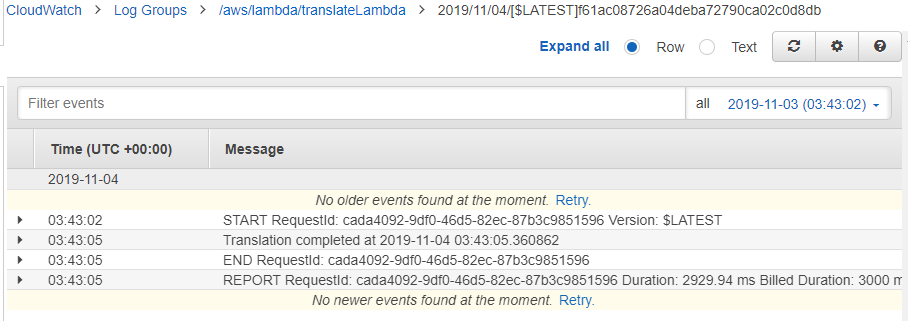
Now when I refresh the CloudWatch log and look at the most recent event, I see the message I printed from the script: Translation completed at 2019-11-04 03:43:05.360862.
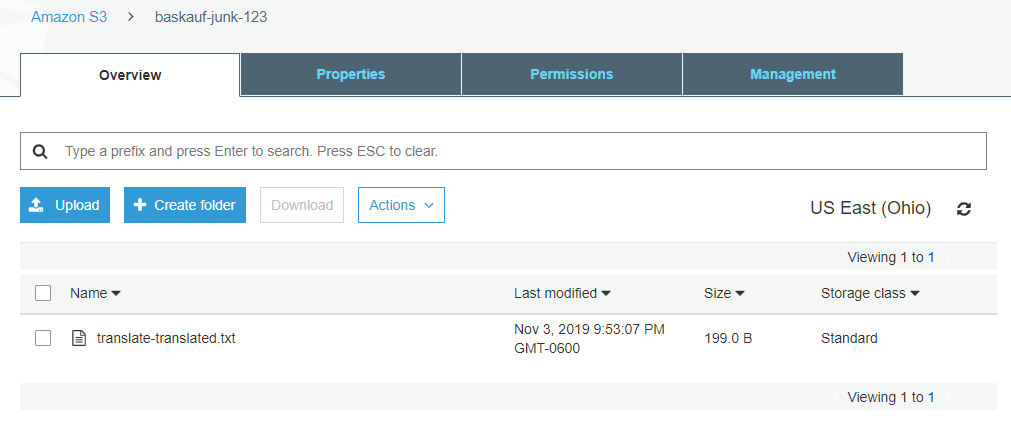
When I check the output bucket that I specified in the script (click refresh), I see an output file named as I specified in the script.

When I download and open the file, I see the translation in the language I requested in the script.
Triggering the Lambda via the CLI
One of the advantages of running the script as a Python Lambda in the cloud rather than a desktop Python script is that a IAM user can trigger the Lambda simply by uploading a file to the S3 bucket and getting the result by downloading a file from an S3 bucket. The IAM user does not have to have any other permissions besides full S3 permissions. The user can also be set up to be restricted to accessing only the particular S3 buckets required for the operation of the script.
Creating very restricted access like this allows workers to assist with carrying out an AWS analysis without the need for you to grant them access to your account online. They also would be unable to modify the Lambda script while using it.

In the example above, my IAM user with only S3 privileges used CLI commands to upload the file translate.txt to the trigger bucket, then download the results and delete both files. The Windows type command (cat in Linux) was used to display the contents of the translation. Since the Command Prompt application can’t display UTF-8 characters, it’s mostly gibberish - I need to use some other application to actually look at the output.
Other useful stuff
This was a very minimal example of using a Lambda. Lambdas can be set up to send you a notification email when they run (usefully for rarely-triggered events). They can also be used to obtain the data from an API rather than from an S3 bucket. In that case, the trigger can be a Cron job scheduled to harvest data from the API at regular intervals. AWS also has easily used cloud databases that can be used to store the output data rather than putting it in a file in a bucket.
Another useful possibility is to string multiple Lambdas sequentially. For example, Amazon Textract could be used to extract text from an image by one Lambda. The output of that Lambda could then trigger Amazon Translate to translate into another language, Amazon Comprehend to do sentiment analysis, or Amazon Polly to convert the text into speech.
Revised 2019-11-05

Questions? Contact us
License: CC BY 4.0.
Credit: "Vanderbilt Libraries Digital Lab - www.library.vanderbilt.edu"